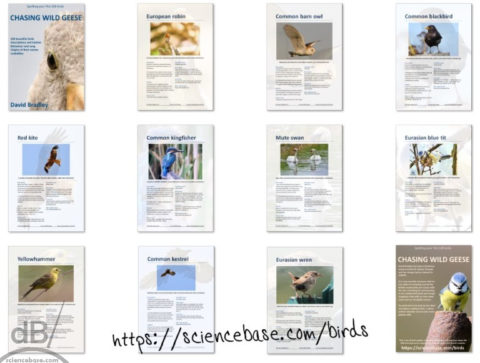 You can get a FREE 11-bird PDF ebook sampler of my forthcoming book: Chasing Wild Geese: Spotting your first 100 birds here.
You can get a FREE 11-bird PDF ebook sampler of my forthcoming book: Chasing Wild Geese: Spotting your first 100 birds here.
Category: Birds
Taking a flight of fancy with our feathered friends
Three herons
You wait around all summer, waiting for a grey heron (Ardea cinerea) and then as the leaves start falling three come along all at once, cavorting and basking in the autumnal sunshine. They took flight when they saw me and the dog, but landed on the other side of the bridge, then began whirling back and forth across the road and landing within 15 metres for me to photograph them. Not sure whether that one in the upper photo was trying to get a better look at my lens or what…




Wren – Troglodytes troglodytes
At the time of writing, the UK’s Environment Agency is busy clearing reeds from the Cottenham Lode to allow the drain to do its job properly in the winter. The reed warblers, reed buntings, whitethroats, corn buntings, meadow pipits, linnets, yellowhammers, and others that spent the summer along the Lode and in the fields and hedgerows close to it all seem quiet or to have moved on. The warblers migrating to warmer climes, the buntings, pipits, and linnets maybe just hiding or perhaps having relocated away from close to the watercourse to elsewhere in the surrounding countryside.
However, I did spot one straggler. The UK’s smallest and most common native bird, the Wren. It was flitting in and out of the reeds and almost playing at reed warbler earlier today possibly taking its last chance to snatch at insects and spiders living among the water plants before that EA dredger scrapes them out of the water and dumps them on the bank of the flood defences.

Wren (Troglodytes troglodytes) – the name Wren comes from a German word of unknown origin. In old High German the bird is also known as a kuningilin meaning kinglet. The troglodytes of its scientific name comes from the Greek meaning something that dives into a (mouse) hole (or in a related sense a “cave dweller”). The doubling of the word makes it a tautonym, which I’ve mentioned before means this species is the “type” of the family.
Having stalked this particular specimen for a few minutes on a drizzly, lunchtime dog walk, I eventually got a decent snap of it clinging to a reed stump (see above) and also caught it as it took flight (below). I should add that this is probably the same specimen I photographed on this exact patch of reeds at the beginning of the year.

Treecreeper – Certhia familiaris
Back in June 2017, I spotted a pair of treecreepers (Certhia familiaris) creeping up a tree in the local, Rampton, woodland. I was too close to get a shot with the zoom lens and by the time I’d stepped back from the tree they’d crept around the back and out of sight, flying off when I took another step towards them. I framed the blurry tail of one of the pair.

Ever since, I walk through the same patch of woodland quietly in the hope that they’re there again, they never are. But, I did see another specimen on the edge of the wood close to the Cottenham Lode. Again, too close for the lens to focus, unfortunately. I’ve seen and photographed the unrelated nuthatch (Sitta europaea) which also creeps up tree trunks and along branches. Treecreepers only creep upwards though.
At last, 3rd October 2017, listening and spotting long-tailed tits in Rampton Spinney (again), I hear some high-pitched warbling among the whistles and chatter of the longtails. Look up at the nearest ash tree and there’s a treecreeper heading up to the canopy. Quick snap of it and then another lands. So, at long last, a decent shot or two of this active and resident British bird, which apparently tags along with tits in autumn and winter. Not to be confused with the short-toed treecreeper (Certhia brachydactyla), which lives in the Channel Islands (presumably for tax purposes)
Ghost of a pigeon at your window
Have you ever seen a grey feathery, pigeon-shaped outline on a window? It’s usually left when a bird has somehow not seen the glass and attempted to fly through. If you’re in the room when it happens it can make a surprisingly loud thud but pigeons seem to crash land after the collision, look very stunned, ruffle their feathers and move on, But, what exactly is that grey powder that they leave behind on your window? It’s known as powder down.
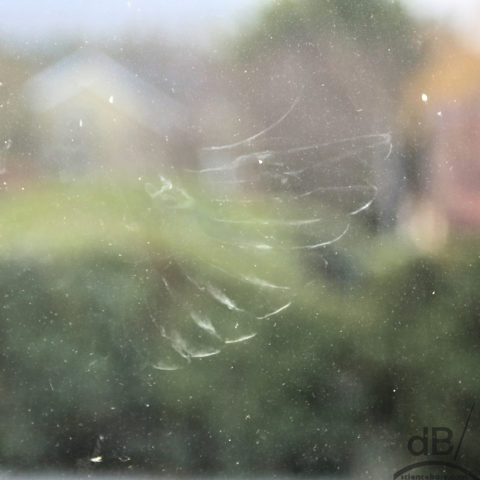
Down feathers are fine feathers found under the tougher exterior feathers. Chicks usually have only down feathers until they grow their adult feathers. Powder down, or pulviplumes, is somewhat different and occurs in a few unrelated groups of birds – pigeons, tinamous, herons, and parrots, for instance. In some species, the tips of the pulviplume barbules break up into a fine powdery form of keratin, which forms a “feather dust” among the feathers. In others, powder grains are generated by cells that surround the barbules of growing feathers.
Powder down is a known allergen and is one of the causes of “bird fancier’s lung” and related conditions in people who keep or work with birds, including pigeons, parakeets, cockatiels, budgerigars, parrots, and turtle doves.
The above picture shows the imprint left by a woodpigeon that had slammed into my office window recently, cropped from the photo is the big smudge of powder down left by its body. You might also like to note that our window cleaner has not visited for quite some time.
Several other species produce powder down too, including notoriously, parrots, although you’re less likely to have a Mealy Amazon slam into a back bedroom window in East Anglia than a Wood Pigeon.
Cranes at Welney Wetland Centre
Today, we took our second trip of the year to WWT Welney. I checked what was “showing” before we set off. Common, or Eurasian, cranes (Grus grus) apparently, more than thirty of them. We saw a few a long way off from the main hide on arrival and then a couple of small flocks in flight later in the day from different vantage points on site.



Of the other birds sighted by others today, we saw: Goldfinch, Linnet, Meadow Pipit, Pied Wagtail, Tree Ssparrow, Marsh Harrier, Kestrel Greenshank, Black-tailed Godwit, Lapwing, Chiffchaff, Tufted Duck, Pochard, Wigeon, Teal, Mallard, Greylag Goose, Canada Goose, Cormorant Grey Heron, and possibly Curlew Sandpiper (but it may well have been merely a Dunlin, in fact, it almost certainly was).
Long-tailed tit
In English we know Aegithalos caudatus as the long-tailed tit. It’s a tit-type passerine bird with a long tail. So much, so obvious. In Germany it’s Die Schwanzmeise, which literally translates as the “tail chick”…which perhaps hints at why Americans call tits chickadees and indeed in French, the long-tailed tit is known as la mésange à longue queue, the long tail chickadee.
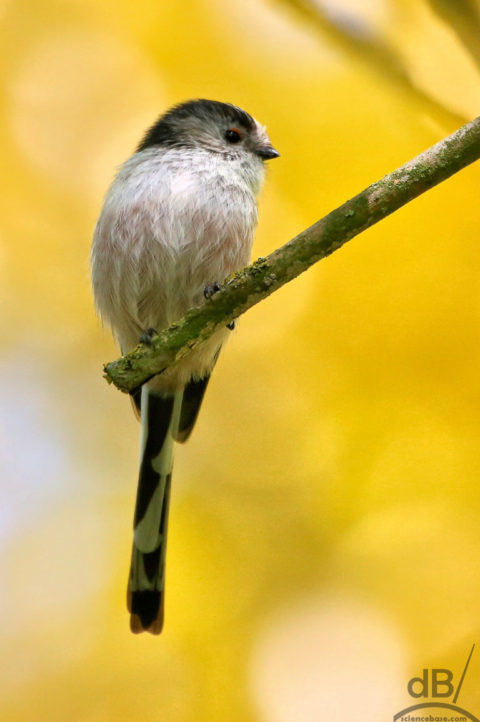
However, A caudatus is not a member of the Poecile genus like the Carolina chickadee, Black-capped chickadee, Mountain chickadee, etc. In North America many of the tit-like birds are chickadees, but they do have some of the same Poecile species as we have in the UK: Marsh tit and Willow tit, for instance. Wikipedia suggests that the term chickadee derives from the call made by the birds “chick-a-dee-dee-dee”. But that sounds like a reverse engineered explanation to me, better ask Mr Fields.
Bush tits, babblers and long-tailed tits…
Departing are such sweet swallows
In some parts of the UK, the migrants have already departed, but there are plenty of swifts, house martins, sand martins, and barn swallows here in East Anglia, from the North Norfolk coast, to deepest Norfolk and west again to Cambridge (well those are the places I’ve seen them this week).
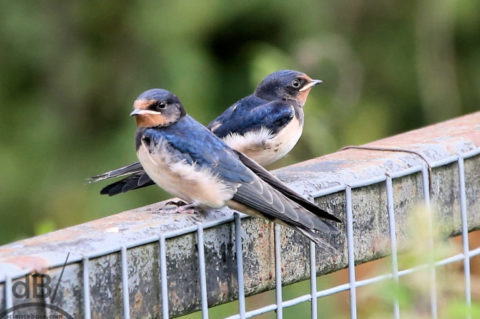
Back in early May, I photographed adult (barn) swallows (Hirundo rustica) getting it on at Bottisham Lock on the River Cam near Waterbeach (north of the city of Cambridge). The adults are still whirling around the skies and scooping up water and insects from the river. These two products of that springtime behaviour were anything but shy when I turned the camera on them.

On a sultry late August afternoon, they seemed to be relaxing, totally oblivious to the fact that in a few days time they will be flying some 300 kilometres a day south. They will cross the perilous Sahara Desert on an approximately 9500 km journey to their winter abode in South Africa. They’re less than four months old and it will take them a month or so to make that journey. And, early next March/April those that survive the journey and the South African summer will head north again to start the cycle once more.
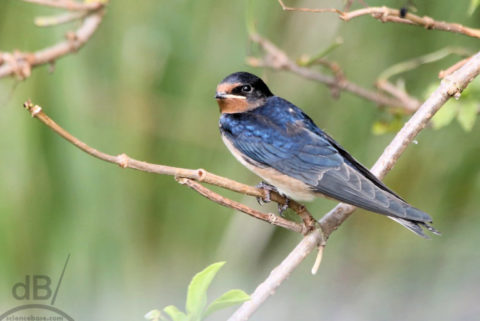
Incidentally, it was not just before Christmas 1912 that we knew for certain that barn swallows seen in the English summer were migrating all the way to South Africa. A bird ringed in the summer by James Masefield in Staffordshire was identified in Natal on 23rd December that year.
Oh, and in case you missed it on Facebook back in May…here’s the earlier activity

Felt inspired by these gorgeous creatures to put together a sultry instrumental on a late summer’s day.
Migrants and the problem of longitude
How do migratory birds like the Eurasian Reed Warbler (Acrocephalus scirpaceus) know which way to go when heading south for the winter? Indeed, how do they find their way back from sub-Saharan Africa in spring to breed among the reeds in the wetlands of Europe and Asia?
The answer may lie with magnetic lines and how they change depending on where on the globe you are.

“It seems that…the Reed Warbler (pictured above) may have a geographic map or memory that enables it to identify its longitudinal position on the globe, only by detecting the magnetic north pole and its variance from true north,” to quote one expert in the article. The birds can detect magnetic declination in other words.

It’s worth noting that another warbler, the Blackcap (Sylvia atricapilla, immediately above) is usually a summer visitor to the British Isles, but some Eastern European and German specimens in migrating south-west to Iberia and south to Africa for the winter have ended up heading west and overwintering in the UK in recent years. They seem to favour our garden feeders over warmth. We had a male Blackcap overwinter with us 2016/2017 and a male and a female during 2017/2018 winter.
Chasing Wild Geese
Scopelessly in love with birds
I’ve always had a soft spot for our feathered friends. After all, they’re the great British wildlife that seems the most abundant and most accessible. There are more birds and more bird species than there are large wild mammals and domesticated animals put together, by a long way. If you start counting the latter: fox, badger, hare, rabbit, stoat, weasel, bank vole, red deer, roe deer, fallow deer, muntjac, cow, sheep, goat, dog, cat etc you quickly come to a halt.
But, start listing the birds and the list goes on and on from Barn Owl and Barn Swallow to Pied Flycatcher and Pied Wagtail, Firecrest to Goldcrest, Crested Tit to Great-crested Grebe. And, don’t forget all those warblers: Barred, Bonelli’s, Cetti’s, Dartford, Fan-tailed, Garden, Grasshopper, Great Reed, Icterine, Marsh, Melodious, Moustached, Reed, Sardinian, Savi’s, Sedge, Subalpine, Western Bonelli’s, Willow, and Wood.

I never took birdwatching too seriously. I was certainly never a twitcher chasing around hill and vale, coast and cove. I was happy to see a new bird, but never jotted down details, never ticked it off in a book.
Superzoom
That changed when superzoom lenses got cheaper. I had a few snaps of birds taken with a small zoom lens, but the purchase of an affordable 150-600mm lens brought the whole world closer. Especially useful for photographing the moon, the ISS or comets in the night skies. Of course, the lens might otherwise be redundant during daylight if it wasn’t for the birds. Birds, I assume have absolutely no concept of just how close you can be through such a lens without really disturbing them.
Twitching or birding?
And so, my latent twitching/birding inclinations began to grow early in 2017. I had a lucky first day with the new lens: flighty blue tits in the garden and a sharp-eyed heron after our neighbours’ goldfish in the pond. Lucky for those pesky piscines, our neighbour had protected them from such aquatic hunters with strong wire mesh. I got a nice close of the frustrated bird up from an upstairs window before he lumbered into the air to find breakfast elsewhere. My first lunchtime dog walk in the winter sun, led me to a majestic Kingfisher perched on the reeds. I’d spotted her once or twice before on walks without a camera. This time, she posed for a moment while I got her close-up all electric blue and saturated orange.
I started to blog about the birds and to build an online gallery. Trips to local nature reserves and country houses added more to the list as did trips to the coast. Before long, I had more than 100 different species: Red Kites, Marsh Harriers, Hobbies, Blackcaps, Great Spotted Woodpeckers, Green Woodpeckers, House Martins, House Sparrows, Tree Sparrows, Dunnocks, Gannets, Kittiwakes, Puffins, Razorbills, Bullfinch, Greenfinch, Chaffinch, and so many more.
Who’s counting?
Birders will tell you that identifying your first 100 is just the start, it gets serious and harder when you are targeting 250. So, here’s a selection of the first few birds you might see should you take up the sport and science of observing birds. Your mileage may vary, you might see a marsh harrier before you spot a Hen Harrier, and Ringed Plovers may come your way before Golden Plovers. You may also try to count Lapwings, Peewits, and Green Plovers as different species, but they are one and the same.
In less enlightened times people preferred to shoot birds with a gun and steal their eggs. But, with a camera, you get to hunt and shoot the same bird again and again. I hope this short guide gives you some clues as to what you might look out for and where you might look in figuratively bagging your first 100 birds.
There are plenty of birds to watch…about ten thousand species worldwide at the last count. So crack out the binoculars and your walking boots or just watch from your garden and maybe tick them off in your head after you confirm the species in the books. It’s not a wild goose chase, honest.
I keep a constantly updated gallery of bird photos on my Imaging Storm site, along with a “tick list”.